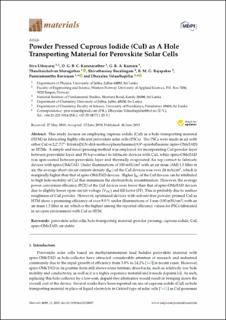| dc.contributor.author | Uthayaraj, Siva | |
| dc.contributor.author | Karunarathne, DGBC | |
| dc.contributor.author | Kumara, GRA | |
| dc.contributor.author | Murugathas, Thanihaichelvan | |
| dc.contributor.author | Rasalingam, Shivatharsiny | |
| dc.contributor.author | Rajapakse, R.M.G. | |
| dc.contributor.author | Ravirajan, Punniyamoorthy | |
| dc.contributor.author | Velauthapillai, Dhayalan | |
| dc.date.accessioned | 2020-03-17T13:41:17Z | |
| dc.date.available | 2020-03-17T13:41:17Z | |
| dc.date.created | 2019-11-07T11:58:48Z | |
| dc.date.issued | 2019 | |
| dc.identifier.citation | Uthayaraj, S., Karunarathne, D., Kumara, G., Murugathas, T., Rasalingam, S., Rajapakse, R., . . . Velauthapillai, D. (2019). Powder pressed cuprous iodide (CuI) as a hole transporting material for perovskite solar cells. Materials, 12(13), 1-9. | en_US |
| dc.identifier.issn | 1996-1944 | |
| dc.identifier.uri | https://hdl.handle.net/11250/2647211 | |
| dc.description.abstract | This study focuses on employing cuprous iodide (CuI) as a hole-transporting material (HTM) in fabricating highly efficient perovskite solar cells (PSCs). The PSCs were made in air with either CuI or 2,2′,7,7′-Tetrakis[N,N-di(4-methoxyphenyl)amino]-9,9′-spirobifluorene (spiro-OMeTAD) as HTMs. A simple and novel pressing method was employed for incorporating CuI powder layer between perovskite layer and Pt top-contact to fabricate devices with CuI, while spiro-OMeTAD was spin-coated between perovskite layer and thermally evaporated Au top-contact to fabricate devices with spiro-OMeTAD. Under illuminations of 100 mW/cm2 with an air mass (AM) 1.5 filter in air, the average short-circuit current density (JSC) of the CuI devices was over 24 mA/cm2, which is marginally higher than that of spiro-OMeTAD devices. Higher JSC of the CuI devices can be attributed to high hole-mobility of CuI that minimizes the electron-hole recombination. However, the average power conversion efficiency (PCE) of the CuI devices were lower than that of spiro-OMeTAD devices due to slightly lower open-circuit voltage (VOC) and fill factor (FF). This is probably due to surface roughness of CuI powder. However, optimized devices with solvent-free powder pressed CuI as HTM show a promising efficiency of over 8.0 % under illuminations of 1 sun (100 mW/cm2) with an air mass 1.5 filter in air, which is the highest among the reported efficiency values for PSCs fabricated in an open environment with CuI as HTM. | en_US |
| dc.language.iso | eng | en_US |
| dc.publisher | MDPI | en_US |
| dc.rights | Navngivelse 4.0 Internasjonal | * |
| dc.rights.uri | http://creativecommons.org/licenses/by/4.0/deed.no | * |
| dc.subject | perovskite solar cells | en_US |
| dc.subject | hole-transporting material | en_US |
| dc.subject | powder pressing | en_US |
| dc.subject | cuprous iodide | en_US |
| dc.subject | CuI | en_US |
| dc.subject | spiro-OMeTAD | en_US |
| dc.subject | air stable | en_US |
| dc.title | Powder pressed cuprous iodide (CuI) as a hole transporting material for perovskite solar cells | en_US |
| dc.type | Peer reviewed | en_US |
| dc.type | Journal article | en_US |
| dc.description.version | publishedVersion | en_US |
| dc.rights.holder | © 2019 by the authors. | en_US |
| dc.source.pagenumber | 9 | en_US |
| dc.source.volume | 12 | en_US |
| dc.source.journal | Materials | en_US |
| dc.source.issue | 13 | en_US |
| dc.identifier.doi | 10.3390/ma12132037 | |
| dc.identifier.cristin | 1744889 | |
| cristin.ispublished | true | |
| cristin.fulltext | original | |
| cristin.qualitycode | 1 | |

